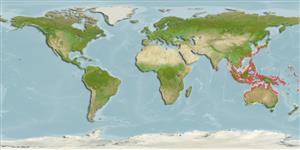>
Gobiiformes (Gobies) >
Gobiidae (Gobies) > Gobiinae
Etymology: Gobiopsis: Latin, gobius = gudgeon + Greek, opsis = appearance (Ref. 45335).
More on author: Snyder.
Environment: milieu / climate zone / depth range / distribution range
Ökologie
seewasser demersal; tiefenbereich 5 - 15 m (Ref. 90102). Tropical
Indo-West Pacific: Japan south to Australia.
Size / Gewicht / Alter
Maturity: Lm ? range ? - ? cm
Max length : 1.6 cm SL Männchen/unbestimmt; (Ref. 38029)
Kurzbeschreibung
Morphologie | Morphometrie
Rückenflossenstacheln (insgesamt): 6 - 7; Rückenflossenweichstrahlen (insgesamt): 9-11; Afterflossenstacheln 1; Afterflossenweichstrahlen: 9. Characterized by pale grey overall body color; mottled brown head, broad saddle over nape region; presence of three brown saddles along base of dorsal fins, joined at midbody to form continuous midlateral stripe; 5-6 narrow brown bars on lower side; fully united pelvic fins, frenum present; relatively short pelvic fins, about 54%distance from origin of pelvic fin to origin of anal fin; rounded caudal fin; longitudinal scale series 33-36; presence of barbels on snout, tip of chin, and ventrally below lower jaw; cycloid scales; cheek and opercle without scales; deeply embedded nape scales; presence of sensory pores on head, no preopercular pores; depth of body 5.7 in SL (Ref. 90102).
Cryptic inhabitant of sand-rubble bottom next to reefs in 5-15 (Ref. 90102).
Life cycle and mating behavior
Geschlechtsreife | Fortpflanzung | Ablaichen | Eier | Fecundity | Larven
Masuda, H., K. Amaoka, C. Araga, T. Uyeno and T. Yoshino, 1984. The fishes of the Japanese Archipelago. Vol. 1. Tokai University Press, Tokyo, Japan. 437 p. (text). (Ref. 559)
IUCN Rote Liste Status (Ref. 130435)
Bedrohung für Menschen
Harmless
Nutzung durch Menschen
Mehr Information
NamenSynonymeMetabolismusRäuberÖkotoxikologieFortpflanzungGeschlechtsreifeAblaichenSpawning aggregationFecundityEierEientwicklung
Alter/GrößeWachstumLänge-GewichtLänge-LängeLängenhäufigkeitenMorphometrieMorphologieLarvenLarven Pop.Dyn.RekrutierungDichteBRUVS
ReferenzenAquakulturAquakultur ProfilZuchtlinienGenetikElectrophoresesVererbbarkeitKrankheitenVerarbeitungNutrientsMass conversion
PartnerBilderStamps, Coins Misc.LauteCiguateraGeschwindigkeitSchwimmstilKiemenoberflächeOtolithsGehirngrößeSehfähigkeit
Tools
Zusatzinformationen
Download XML
Internet Quellen
Estimates based on models
Preferred temperature (Ref.
123201): 25.2 - 29.3, mean 28.6 °C (based on 1983 cells).
Phylogenetic diversity index (Ref.
82804): PD
50 = 0.5001 [Uniqueness, from 0.5 = low to 2.0 = high].
Bayesian length-weight: a=0.00708 (0.00333 - 0.01504), b=3.09 (2.92 - 3.26), in cm total length, based on LWR estimates for this (Sub)family-body shape (Ref.
93245).
Trophic level (Ref.
69278): 3.0 ±0.3 se; based on size and trophs of closest relatives
Widerstandsfähigkeit (Ref.
120179): hoch, Verdopplung der Population dauert weniger als 15 Monate. (Preliminary K or Fecundity.).
Fishing Vulnerability (Ref.
59153): Low vulnerability (10 of 100).
